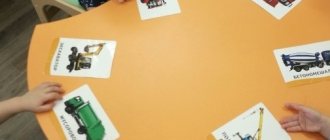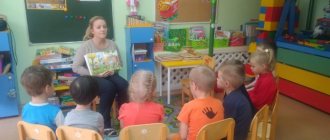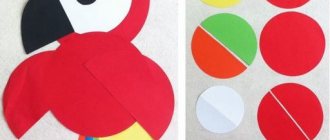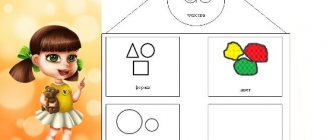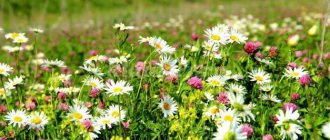Work program on FEMP for children of the older group. Explanatory note
Olga Ilyina
Work program on FEMP for children of the older group. Explanatory note
GCD thematic plan
Explanatory note.
of great importance in the mental education of children . A condition for the successful implementation of a program in elementary mathematics is the organization of a special subject-development environment in groups in the kindergarten area for direct action of children with specially selected groups of objects and materials in the process of mastering mathematical content. In the sixth year of life, the level of mental development of a child is characterized by a significant accumulation of visual and sensory ideas and simple concepts. The child actively develops visual imaginative thinking, voluntary attention, memory, and the ability to control his behavior. He is characterized by a desire to perform tasks that are more generalized and complex in content and receive a positive assessment from an adult for this. Training is carried out based on clarity, previously acquired knowledge and experience in solving certain mathematical problems. Each new idea (concept)
is formed on the basis of its inclusion in the previously acquired system.
Work program of cognitive and speech direction on FEMP for children of the older group
(from 5 to 6 years old)
compiled in accordance with federal state requirements for the structure of the main general education
program of preschool education, based on the main general education program .
The program provides for:
• diagnostic classes – 4;
• practical lessons –35.
The program is compiled in accordance with thematic cycles, which creates the basis for the development of children’s :
1. "Speech development"
— development of monologue speech when describing your
works .
2. “Reading fiction”
- drawing based on the impressions of read fairy tales and literary works.
3. “Formation of a holistic picture of the world”
- broadening one’s horizons in the process of various observations, activities to get acquainted with the environment (people, nature, the world, as well as familiarity with the structure of objects, objects.
4. “Formation of elementary mathematical concepts”
- familiarization with the names and characteristics of the simplest geometric shapes, an idea of the spatial position of objects and their parts
(left, right, corner, center, etc.)
and quantities
(more, less)
.
The purpose of teaching mathematics is not only to prepare for successful mastery of mathematics at school, but also the full development of the child:
-development of the motivational sphere;
— intellectual creative forces;
- personality qualities.
Program objectives :
1. Creating the most favorable conditions for the early identification and development of the child’s interests, inclinations and abilities.
2. Formation of internal learning motivation and other motives for learning.
3. Development of mental processes (sensation, perception, representation)
.
4. Development of variable and imaginative thinking (fantasies, imagination, creativity)
.
5. Formation of methods of mental action (analysis, synthesis, comparison, generalization, classification, analogy)
.
6. Formation of abilities and skills (the ability to think and plan actions, implement decisions, guess about the results and check them, strictly adhere to the given rules of the algorithm.)
Forms of organization of NOD.
1. Frontal work with demonstration material.
2. Independent work with handouts.
3. Statement and resolution of problem situations.
4. Experimentation.
5. Physical education minutes.
.The solution of problems specified in of the program is carried out in conjunction with other
meaningful activities, such as environmental, visual, constructive, etc.
Quantity and count
Strengthen the ability to create sets ( groups of objects )
from elements of different quality
(objects of different colors, sizes, shapes, purposes; sounds, movements)
;
break sets into parts and reunite them; establish relationships between the whole set and each of its parts, understand that the set is larger than the part, and the part is less than the whole set; compare different parts of a set based on counting and correlating elements (objects)
one to one;
determine the larger (smaller)
part of the set or their equality.
Strengthen the ability to count to 10; consistently introduce the formation of each number within 5-10 (on a visual basis)
.
Develop the ability to compare adjacent numbers within 10 based on comparison of specific sets; obtain equality from inequality (inequality from equality, adding one item to a smaller quantity or removing one item from a larger quantity ( "7 is less than 8, if you add one item to 7, it will be 8, equally"
,
“8 is greater than 7; if you remove one from 8 objects, then there will be 7, equally"
).
Develop the ability to count objects from a large number according to a pattern and a given number (within 10)
.
Develop the ability to count objects by touch, count and reproduce the number of sounds, movements according to a pattern and a given number (within 10)
.
Introduce numbers from 0 to 9.
Introduce ordinal counting within 10, learn to distinguish between the questions “How much?”
,
"Which?"
(
“Which one?”
) and answer them correctly.
Continue to form an idea of equality: determine equal numbers in groups consisting of different subjects; correctly generalize numerical values based on counting and comparing groups (here there are 5 cockerels, 5 nesting dolls, 5 cars - all toys equally - 5 each)
.
Exercise in understanding that the number does not depend on the size of objects, the distance between objects, shape, their location, as well as the direction of counting (from right to left, from left to right, from any object)
.
Introduce the quantitative composition of numbers from units within 5 on specific material: 5 is one, one more, one more, one more and one more.
Form the concept that an object (sheet of paper, tape, circle, square, etc.)
can be divided into several equal parts
(two, four)
.
Strengthen the ability to name parts obtained from division, compare the whole and parts, understand that the whole object is larger than each of its parts - the part is smaller than the whole.
Magnitude
Strengthen the ability to establish dimensional relationships between 5-10 objects of different lengths (height, width)
or thickness: systematize objects, arranging them in ascending
(descending)
order by size; reflect in speech the order of objects and the relationship between them in size; “The pink ribbon is the widest, the purple one is a little narrower, the red one is even narrower, but it is wider than the yellow one, and the green one is narrower than the yellow one and all the other ribbons,” etc.
Develop the ability to compare two objects by size (length, width, height)
indirectly - with the help of a third (conditional measure equal to one of the objects being compared.
Develop the eye, the ability to find objects longer (shorter, higher (lower)
.
wider (narrower, thicker (thinner)
than the sample and equal to it.
Form
Introduce an oval by comparing it with a circle and a rectangle. Give an idea of a quadrilateral: bring to the understanding that a square and a rectangle are varieties of a quadrilateral.
Develop geometric vigilance: the ability to analyze and compare objects by shape, to find objects of the same and different shapes in the immediate environment: books, paintings, blankets, table tops - rectangular, tray and dish - oval, plates - round, etc.
Develop an idea of how to make another from one form.
Orientation in space
Improve the ability to navigate in the surrounding space; understand the meaning of spatial relationships (above - below, in front (in front)
- behind
(behind, left - right, between, next to, about)
;
move in a given direction, changing it according to a signal, as well as in accordance with signs indicating the direction of movement (forward, backward, left, right, etc.)
; determine your location among surrounding people and objects: “I am standing between Olya and Tanya, behind Misha, behind
(behind)
Katya, in front of Natasha, near Yura”; indicate in speech the relative positions of objects: “To the right of the doll sits a hare, and to the left of the doll is a horse, behind is a bear, and in front is a car.”
Develop the ability to navigate on a sheet of paper (right - left, top - bottom, middle, corner)
.
Time orientation
Give an idea that morning, evening, day, night make up a day.
Strengthen the ability to establish the sequence of various events using specific examples: what happened before (first, what later (then, determine what day is today, what was yesterday, what will be tomorrow.
The program is designed taking into account the integration of educational areas:
Types of integration of the educational field “Cognition”
By objectives and content of psychological and pedagogical work By means of organizing and optimizing the educational process
— "Communication"
- development of cognitive, research and productive activities in the process of free communication with peers and adults).
— "Reading fiction"
- solving by specific means the identical main task of psychological and pedagogical
work - the formation of a holistic picture of the world.
- "Health"
— expanding
children’s in terms of ideas about a healthy lifestyle.
— “Socialization”
— formation of a holistic picture of the world and broadening one’s horizons in terms of ideas about oneself, family, society, state, and the world.
— "Work"
— formation of a holistic picture of the world and broadening one’s horizons in terms of ideas about the work of adults and one’s own work activity.
— "Safety"
— formation of a holistic picture of the world and broadening one’s horizons in terms of ideas about the safety of one’s own life and the safety of the surrounding natural world.
— "Music"
and
“Artistic creativity” (expanding one’s horizons in terms of musical and visual arts)
.
“Reading fiction”
(using works of fiction to form a holistic picture of the world).
"Music"
and
“Artistic creativity”,
the use of musical works, means of
children’s to enrich the content of the “Cognition”
.
Expected results
By the end of the year, six-year-olds can:
• Identify the components of a group of objects , their characteristics, differences and similarities, compare parts based on counting objects and composing steps, understand that a part is smaller than the whole.
• Count to 10.
• Correctly use cardinal and ordinal numbers, answer the questions “How much?”
,
“Which one is it?”
• Compare adjacent numbers within 10, equalize unequal groups of objects in 2 ways.
• Compare objects by length (width, height, thickness)
using an overlay,application.
• Place objects of different sizes (up to 7-10)
in ascending, descending order of their width, length, height, thickness.
• Know the characteristic features of familiar geometric figures (Number of angles, sides, equality, inequality of sides)
•Distinguish the shape of objects: round, quadrangular, rectangular.
• Know the sequence of parts of the day.
• Name the current month, day of the week.
